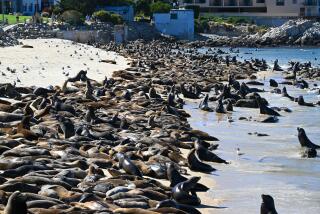Transferring Sea Otters to San Nicholas Island
- Share via
Recently students at Eastshore Elementary School wrote to The Times (Nov. 13) questioning the wisdom of moving sea otters to San Nicholas Island.
Before Europeans nearly made them extinct by killing them for their fur, California sea otters ranged from the Northern California coast into Baja California and throughout the Channel Islands.
Now California sea otters are only about one-tenth their former numbers. The existing 1,700-member sea otter colony reproduces at a 5% rate of growth, enough to support the planned transfer. The San Nicholas Island colony is intended to be a safeguard against the daily threat to the existing colony of a major oil spill, disease or other causes.
The 14 otters that swam away from San Nicholas Island returned to their former homes on the Central California coast, according to Rachel Saunders, biologist for Friends of the Sea Otter, a Monterey-based group. Since these otters were mostly older ones weighing more than 35 pounds, in future transfers only otters 25 to 35 pounds will be used.
Six of the 12 otter deaths were caused by the stress of capture and holding. In future transfers, time in captivity and exposure to people will be minimized, Saunders said. Of the remaining deaths, one otter was shot, one died of unknown causes and three or four were reported drowned at other Channel Islands.
In August, 20 otters were counted at San Nicholas Island, but in September and October, observers on shore saw only 14. However, kelp beds expand in the fall, and it is believed that the rest of the otters were farther offshore and out of sight in the kelp.
Three successful transfers of the Alaskan sea otter have already taken place, one to British Columbia, one to Washington state and one to Southeast Alaska, Saunders said. Although all three suffered initial decline and took 10 to 15 years to become fully established, today they are thriving colonies.
I hope the next time Karen Rhoads gives her students an assignment that she recommends they dig a little deeper into the subject as well as consulting primary sources: for instance, the U.S. Fish and Wildlife Service, the Department of Fish and Game and Friends of the Sea Otter.
CONSTANCE E. SPENGER
Fullerton
More to Read
Sign up for Essential California
The most important California stories and recommendations in your inbox every morning.
You may occasionally receive promotional content from the Los Angeles Times.










